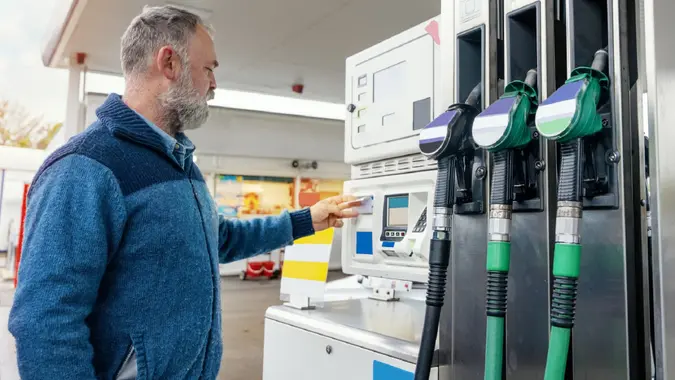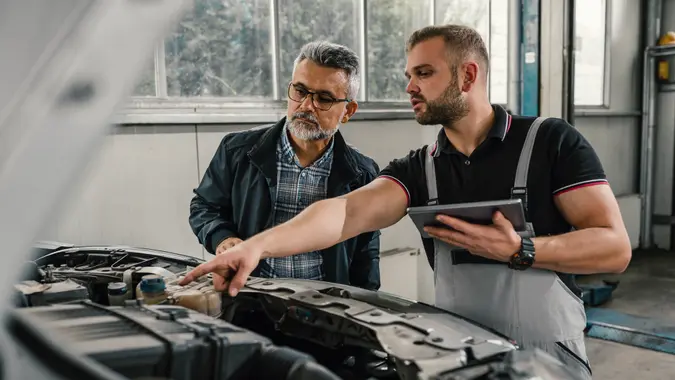5 Appliances That Will Not Hike Up Your Electricity Bills This Winter

Commitment to Our Readers
GOBankingRates' editorial team is committed to bringing you unbiased reviews and information. We use data-driven methodologies to evaluate financial products and services - our reviews and ratings are not influenced by advertisers. You can read more about our editorial guidelines and our products and services review methodology.

20 Years
Helping You Live Richer

Reviewed
by Experts

Trusted by
Millions of Readers
Household utility costs are highest in the hottest and coldest months, so now that the deep freeze is creeping in, you’re probably looking for ways to put your home on an energy diet.
Your electric bill is a great place to start, but you should know that not all appliances zap your wallet equally.
Slow Cookers
Some of your favorite winter comfort foods cook slow and low in a crock pot, but hours of all-day simmering is bound to jack up your electric bill, right? Actually, it’s one of the cheapest ways to put food on the table.
“A slow cooker is one of the most energy-efficient kitchen appliances available to you, with it only using around 1.3 kWh per meal,” said Ben Dhesi, the creator of the energy-saving mobile app HUGO.
Conserve Energy Future confirms Dhesi’s calculations, stating that a slow cooker consumes between 1.2 and 1.7 kWh of electricity during eight hours of use. According to the Bureau of Labor Statistics, 1 kWh costs an average of $0.17.
By comparison, your oven burns 2.4 kWh every hour. Preheating your oven alone costs more than running your crock pot for an entire 9-to-5 workday.
Microwaves
Your oven consumes more electricity than nearly any other appliance in the kitchen, but your microwave can take a whole lot of pressure off your electric bill. According to CNET, using your microwave for one hour per day uses half the total energy as using a gas oven for an hour and 60% less than an electric oven — and since it cooks things so much faster, you’ll rarely use a microwave for a full 60 minutes.
But the microwave won’t always cut it for cooking your favorite winter dishes, so when you must use your oven, use it wisely.
“Consider batch-cooking in bulk a couple of times a week,” said Dhesi. “This means you will be able to make the most of the oven space while minimizing the amount of time your oven is on. These meals can then be heated up later in the week using the microwave.”
Other smart oven tips include:
- Keep the oven door closed while cooking unless you absolutely must open it.
- Pre-cook vegetables.
- Use the right baking container for the task.
- Cut food into smaller pieces.
- Keep your oven well-maintained.
- Turn the oven off five minutes before the time is up.
Energy-Efficient Refrigerators
If you can afford to replace only one major appliance with an energy-efficient upgrade this winter, there are two reasons why you should make it your fridge. First, unlike the oven, refrigerators don’t have a microwave or slow cooker alternative — virtually every modern household must run a refrigerator 24 hours a day. Second, your fridge gobbles up more energy than any other kitchen appliance and more than nearly any other appliance in your whole house. According to Chariot Energy, your fridge accounts for 7% of your home’s total energy use — only air conditioners, space heaters, water heaters and lighting consume more.
“Energy Star-rated refrigerators are designed to be energy-efficient, helping you save on electricity costs while keeping your food cold,” said finance expert Brian Quigley, founder of Beacon Lending, which helps struggling families find homes they can afford to buy and own.
The Department of Energy says EnergyStar-certified refrigerators can slash your bill by 9%.
Electric Kettles
If hot chocolate, coffee, tea, hot cider, hot toddies, mulled wine or any other steaming beverage is part of your winter repertoire, an investment in an electric kettle could take a bite out of your seasonal electric bill.
That’s because ovens aren’t just energy hogs on the inside. The stovetop ranges that sit atop them are inefficient, too.
“If you enjoy hot beverages during the colder months, electric kettles are a quick and energy-efficient way to heat water compared to using a stovetop,” said Quigley.
According to the home appliance site Comfee, electric kettles use 80% less energy than other water-heating methods. On top of that, they heat water much faster and come equipped with exact temperature controls.
Hair Dryers
Few things are less pleasurable than walking outside in the freezing cold and howling wind with a damp head — but don’t let energy anxiety keep you from indulging in the good feeling of blasting your hair with warm air after a hot shower on a cold day.
“Hair dryers are very energy-efficient, all things considered,” said Dhesi.
According to EnergySage, the average hair dryer uses about 1,500 to 2,000 watts of electricity. Ten minutes of daily use will cost you only about $1.30 per month or $15.54 per year.
They’re so efficient, in fact, that Dhesi recommends blow-drying lightly damp clothes instead of running the dryer.
More From GOBankingRates
 Written by
Written by  Edited by
Edited by 
























